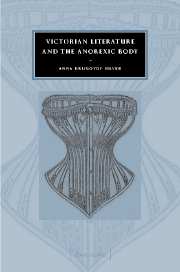Book contents
- Frontmatter
- Contents
- Acknowledgments
- Introduction
- 1 Waisted women: reading Victorian slenderness
- 2 Appetite in Victorian children's literature
- 3 Hunger and repression in Shirley and Villette
- 4 Vampirism and the anorexic paradigm
- 5 Christina Rossetti's sacred hunger
- Conclusion: the politics of thinness
- Notes
- Bibliography
- Index
- CAMBRIDGE STUDIES IN NINETEENTH-CENTURY LITERATURE AND CULTURE
3 - Hunger and repression in Shirley and Villette
Published online by Cambridge University Press: 22 September 2009
- Frontmatter
- Contents
- Acknowledgments
- Introduction
- 1 Waisted women: reading Victorian slenderness
- 2 Appetite in Victorian children's literature
- 3 Hunger and repression in Shirley and Villette
- 4 Vampirism and the anorexic paradigm
- 5 Christina Rossetti's sacred hunger
- Conclusion: the politics of thinness
- Notes
- Bibliography
- Index
- CAMBRIDGE STUDIES IN NINETEENTH-CENTURY LITERATURE AND CULTURE
Summary
Although they wrote as contemporaries, Charlotte Brontë and Charles Dickens never met, nor did they hold high opinions of each other's work. Brontë enjoyed David Copperfield, but she criticized those portions of Bleak House narrated by Esther as “too often weak and twaddling.” Even her compliments of Dickens are noticeably strained. When commenting on David Copperfield, she only commends Dickens for his “varied knowledge of men and things,” tepid praise when juxtaposed with her summation of Goëthe, in the same paragraph, as “Great, powerful, giant-souled” (Correspondence III: 20). Dickens was even less enthusiastic about Brontë, reportedly announcing in 1860 that “he had not read Jane Eyre and … never would as he disapproved of the whole school.” Probably, like so many other Victorian readers, Dickens would have found the character of Jane coarse and vulgar and would have distinguished his own more rarefied and conventional heroines from those of Brontë's “school.” Despite the many differences between Dickens's and Brontë's novels, however, the two authors share a proclivity for slender female heroines that runs throughout both of their works: Jane Eyre, Frances Henri, Caroline Helston, and Lucy Snowe have the same slim, contourless bodies as do Agnes Copperfield, Rose Maylie, Mary Graham, and Amy Dorritt, to name only a few.
Dickens typically employs the slender female body as a marker of his heroines' selflessness and lack of sensuality, going so far as to sentimentalize hunger and starvation.
- Type
- Chapter
- Information
- Victorian Literature and the Anorexic Body , pp. 81 - 115Publisher: Cambridge University PressPrint publication year: 2002



